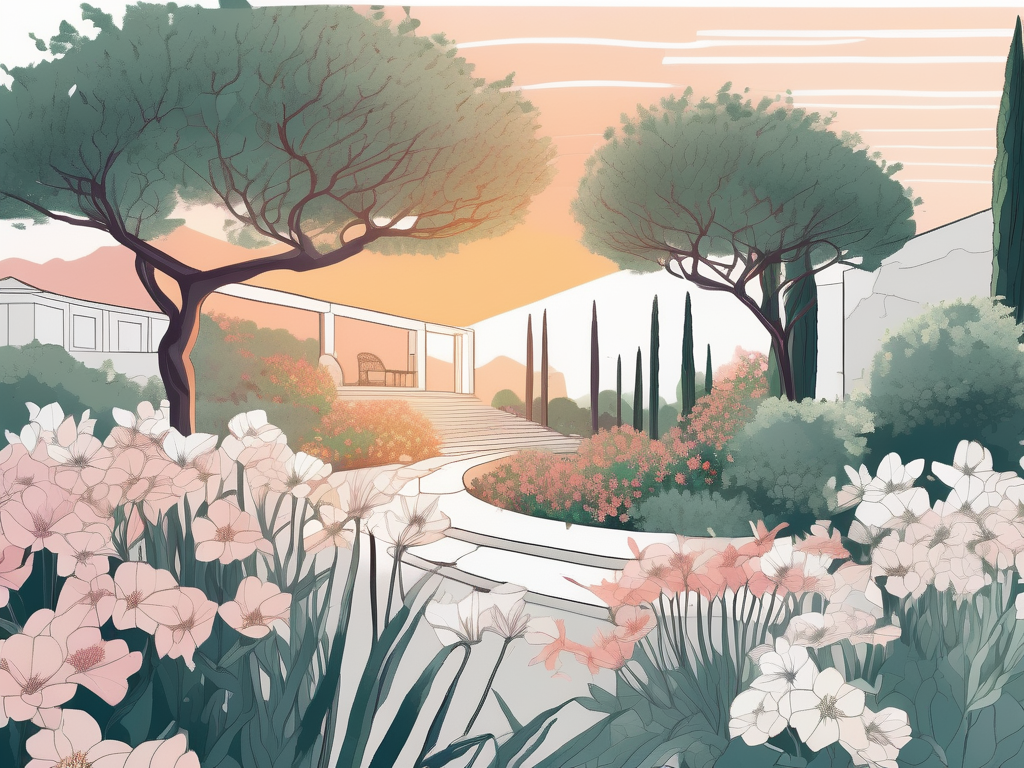In the vast pantheon of Greek gods and goddesses, there are many figures that captivate our imagination. One such deity is Antheia, a mysterious and enigmatic goddess associated with flowers and swamps. Today, we embark on a journey to understand the significance of Antheia in Greek mythology, her symbolism, her connections with other divine beings, the worship and rituals dedicated to her, and her enduring influence on modern culture.
Understanding Antheia: The Goddess of Flowers and Swamps
Antheia holds a unique place among the Greek deities, as she represents the delicate beauty of flowers and the untamed wilderness of swamps. Her name itself means “flower” in Greek, and this association can be seen in her enduring role in mythology.
In ancient Greek tales, Antheia is often depicted as a gentle goddess who radiates charm and allure. Yet beneath her serene exterior lies an intriguing depth associated with the untamed beauty of swampy marshes and flowering meadows.
Legend has it that Antheia’s origins can be traced back to the early days of Greek mythology. She was born as one of the Charites, commonly known as the Graces. Alongside her sisters Aglaea and Euphrosyne, Antheia personified beauty, charm, and mirth. These deity sisters were often depicted adorning the courts of other gods and goddesses with their elegance and grace.
Antheia’s presence often signifies moments of joy, abundance, and flourishing. She is said to have brought forth the blossoming beauty of nature, ensuring the earth was adorned with vibrant colors and sweet scents. In the springtime, when the world awakens from its winter slumber, it is said that Antheia’s touch can be felt in every blooming flower and in the gentle rustling of leaves.
However, Antheia’s significance goes beyond her role as a deity of flowers. She holds overarching symbolism in Greek mythology, representing the transient nature of existence, the ephemeral life cycle of plants, and the impermanence of beauty. Just like flowers that bloom and wither, Antheia reminds us to appreciate the fleeting moments of beauty in our own lives.
Her symbolism teaches us the importance of embracing the present, for just as flowers must eventually fade, so too must all things in life. Antheia’s wisdom encourages us to find beauty in every passing moment, to cherish the vibrant colors and sweet scents that surround us, and to recognize the delicate balance between the untamed wilderness and the delicate beauty that exists within us all.
So the next time you find yourself in a blooming meadow or near a tranquil swamp, take a moment to reflect on the essence of Antheia. Feel the connection between the vibrant flowers and the untamed wilderness, and let her remind you of the beauty that can be found in both the delicate and the wild.
Antheia’s Connection with Other Greek Deities
Antheia’s influence extends beyond her association with flowers and swamps. She is intricately linked to other deities, contributing to her complex character and significance within Greek mythology.
As we delve deeper into Antheia’s divine connections, we discover the profound friendships she forged with other gods and goddesses, each adding a unique dimension to her character.
Antheia and Aphrodite: A Divine Friendship
One of the most notable connections is Antheia’s friendship with Aphrodite, the goddess of love and beauty. Antheia and Aphrodite often worked together, bringing enchantment and allure to the mortal world. Together, they wove a tapestry of love and desire that charmed both gods and humans alike.
Legend has it that whenever a flower bloomed or a couple fell in love, it was the combined efforts of Antheia and Aphrodite. Their divine bond ensured that love, beauty, and desire continued to thrive in the world.
It is said that whenever Aphrodite adorned herself with flowers, Antheia’s presence enhanced her radiance, making her irresistible to all who beheld her. In return, Aphrodite bestowed upon Antheia the power to transform even the most barren landscapes into breathtaking gardens, teeming with vibrant blossoms.
Together, Antheia and Aphrodite embarked on countless adventures, spreading their enchanting influence across the realms of mortals and immortals alike. Their friendship was a testament to the harmonious relationship between beauty and nature.
Antheia and Dionysus: The Wine and the Flower
In addition to her friendship with Aphrodite, Antheia also shares a connection with Dionysus, the god of wine and revelry. In ancient Greek culture, flowers were often used to adorn wine vessels and festivals dedicated to Dionysus.
Antheia’s role in these celebrations was crucial, as she symbolized the harmony between nature and the intoxicating pleasures of the world. Her presence ensured that the wine flowed freely and the festivities remained vibrant and joyous.
It is said that whenever Dionysus would journey through the vineyards, Antheia would follow in his wake, bestowing her blessings upon the grapes. As a result, the wine produced from these vineyards possessed an otherworldly quality, captivating all who tasted it.
During the grand festivals dedicated to Dionysus, Antheia’s presence was felt in every corner. She would weave garlands of flowers, adorning the revelers and infusing the atmosphere with an intoxicating fragrance. Her touch transformed the festivities into a sensory feast, where the boundaries between mortals and gods blurred.
Together, Antheia and Dionysus embodied the harmonious relationship between nature’s beauty and the intoxicating pleasures of life. Their connection emphasized the transformative power of flowers and wine, reminding mortals of the interconnectedness between the earthly and the divine.
Worship and Rituals Associated with Antheia
Throughout ancient Greece, Antheia, the goddess of flowers and blossoms, was honored through various rituals and celebrations. These religious practices were dedicated to expressing gratitude for the beauty she bestowed upon the world and seeking her blessings for bountiful harvests.
Legend has it that Antheia, with her radiant presence, would grace the earth with an array of vibrant colors and fragrances, transforming the mundane into a tapestry of natural wonders. To honor her divine essence, the ancient Greeks held festivals and built temples, creating spaces where mortals could connect with the ethereal energy that Antheia embodied.
Ancient Festivals Celebrating Antheia
One of the most famous festivals in honor of Antheia was the Anthesteria, held in Athens. This three-day celebration marked the arrival of spring and the blossoming of flowers. The city would be adorned with garlands and wreaths, as devotees gathered to offer flowers, perform music and dance, and indulge in feasts filled with wine and delicacies.
The air would be filled with the melodious sounds of lyres and flutes, as dancers gracefully swayed to the rhythm of the music. The streets would come alive with vibrant processions, with people dressed in colorful garments, carrying baskets overflowing with the most exquisite blooms. The fragrance of roses, lilies, and hyacinths would permeate the atmosphere, creating an intoxicating sensory experience.
On a smaller scale, communities throughout Greece would hold local festivals to honor Antheia. These gatherings provided an opportunity for people to come together, appreciate the beauty of nature, and express their gratitude for the goddess’s blessings. In these intimate celebrations, families and friends would gather in fields adorned with flowers, engaging in joyful activities such as weaving floral wreaths, singing hymns, and sharing stories of Antheia’s miracles.
Antheia’s Temples and Sacred Sites
Antheia’s influence extended beyond the city limits of Athens. She was revered in various regions of Greece, resulting in the construction of numerous temples and sacred sites dedicated to her worship. The most renowned temple was located in Kythira, a small island where Antheia was believed to have had a significant presence.
The temple in Kythira stood as a testament to the devotion of the island’s inhabitants. Its grandeur was unparalleled, with towering columns adorned with intricate carvings of flowers and vines. Inside, the air was filled with the aroma of incense, and the walls were adorned with frescoes depicting Antheia’s mythical tales.
Devotees would journey to these sacred locations from far and wide, their hearts filled with reverence and hope. They would offer prayers, make offerings of flowers, and seek blessings for prosperous harvests and a harmonious existence. These temples were considered sanctuaries, where mortals could escape the chaos of everyday life and immerse themselves in the tranquility of Antheia’s presence.
Outside the temples, sacred groves dedicated to Antheia would flourish, serving as places of contemplation and communion with nature. These serene sanctuaries were adorned with an abundance of flowers, their petals gently swaying in the breeze, as if dancing in harmony with the divine.
As the sun set on the ancient Greek civilization, the legacy of Antheia’s worship endured. Her name became synonymous with the beauty and grace that permeated the natural world, and her festivals and temples continued to inspire awe and reverence for generations to come.
Antheia’s Influence on Modern Culture
Despite the passage of time, Antheia’s captivating allure continues to resonate in contemporary art, literature, and spirituality.
Antheia in Literature and Art
Throughout history, writers and artists have drawn inspiration from Antheia’s mythical persona. From poetic verses describing her beauty to paintings depicting lush gardens in full bloom, Antheia’s essence remains a subject of fascination.
Her symbolism is often invoked in works of literature and art, serving as a reminder of the transient nature of life and the importance of cherishing moments of beauty. Antheia’s presence in these creative endeavors ensures her legacy as a goddess who stirs the imagination and kindles the desire for aesthetical experiences.
Antheia’s Impact on Modern Paganism
As interest in ancient Greek mythology and spirituality has grown, Antheia has gained a renewed following among modern Pagans and those seeking a connection with nature and beauty.
Many Pagans honor Antheia through rituals that involve flower offerings, tending to gardens, and cultivating an appreciation for the natural world. The goddess’s association with the untamed wilderness resonates with those seeking a closer bond with the earth and its wondrous flora.
Exploring the Enigmatic Greek Goddess
Antheia, the goddess of flowers and swamps, continues to captivate us with her paradoxical nature and intricate connections with other Greek deities. Through her role in Greek mythology, her symbolism, her influence on worship and rituals, and her lasting impact on modern culture, Antheia remains an enigmatic figure worth exploring.
As we delve deeper into the stories and traditions surrounding this divine goddess, we discover not only her significance in the ancient world but also the timeless wisdom she imparts. Antheia teaches us to embrace beauty in its various forms, to savor fleeting moments, and to cultivate a deep reverence for the enchantment found in the natural world.
Join us in this exploration of Antheia and discover the beguiling secrets hidden within the delicate petals and lush swamps of Greek mythology’s enchanting flower goddess.












